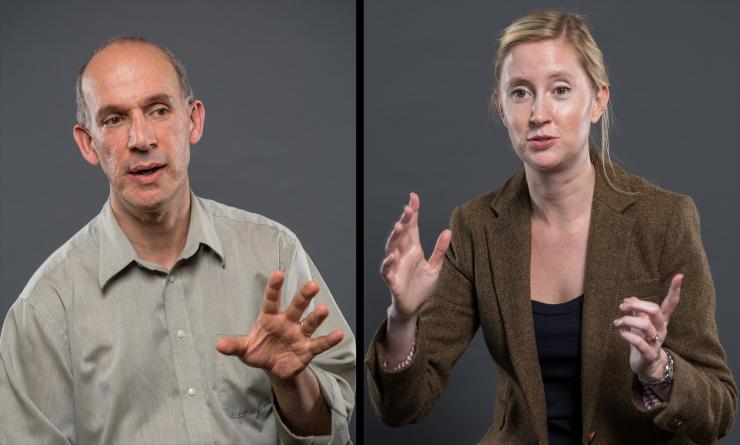
July 21, 2020
Most people are healthy most of the time because their immune systems defeat invading microbes every day. Much of this battle occurs in the lymphatics, a steadfast network of vessels routing lymph fluid through nodes all over the body. These lymph nodes filter the fluid, extract useful information from trapped invaders (like bacteria or cancer cells), and rally the body’s immune system to fight them off.
But sometimes the immune system needs help. Biomedical researchers have understood for years that the selective delivery of a therapeutic payload to the lymph nodes has the potential to address a variety of unmet clinical needs. Unfortunately, delivering cargo to specific cells in this environment is difficult, owing to the unique structure of the lymphatics and the size-restrictive nature of the lymph node reticular network.
But a team of Georgia Tech researchers who have been collaborating for seven years has found a way into the network and they tell all about it in a recently published paper in the journal Nature Nanotechnology.
“If you want to help the immune system fight something off with the right drugs, it makes sense to deliver those drugs to the lymph nodes, since that is where the body’s immune response is developed,” reasons M.G. Finn, researcher in the Petit Institute for Bioengineering and Bioscience and chair of the School of Chemistry and Biochemistry at Georgia Tech, and one of the paper’s authors.
The paper, “Programmable multistage drug delivery to lymph nodes,” provides the latest insights from the long collaboration between Finn’s lab and the lab of Susan Thomas, a Parker H. Petit Institute researcher and associate professor and Woodruff Professor in the George W. Woodruff School of Mechanical Engineering at Tech, with appointments in both the Wallace H. Coulter Department of Biomedical Engineering at Georgia Tech and Emory, and the School of Biological Sciences at Tech.
Basically, the team combined nanoparticles (developed in the Thomas lab) which are rapidly conveyed to draining lymph nodes after administration in peripheral tissues, with programmable degradable linkers (developed in the Finn lab), to overcome lymphatic and intra-lymph node transport barriers. Finn likens the process to a Trojan Horse drama at the molecular level, but with a twist. In this story, the city of Troy doesn’t bring the horse inside of its gates – but it doesn’t matter, because the payload gets in anyway.
“I love the metaphor because Susan’s particles, when administered in a certain way, go to the lymph node naturally and because of their size and how they behave, they’re like the Trojan Horse, efficiently carried to the gates,” Finn says as a way of explaining the delicate and complex dance of chemistry and engineering that brings the Thomas lab’s nanoparticles to the lymph node, where the Finn lab’s technology releases the drugs, which essentially diffuse into the lymph node.
“It’s a much more efficient than an injection into the bloodstream,” Finn says of the methodology. “And it’s unique because no one else has developed this kind of two-stage, Trojan Horse phenomenon for lymph nodes. It’s been done in many different ways for tumors.”
In fact, that was the team’s original intent years ago, after Thomas and Finn got acquainted through a monthly function at the Petit Institute, the monthly Breakfast Club Seminar, and their early work together was supported by a Petit Institute Seed Grant.
“The idea was to use our multistage approach for tumor drug delivery,” says Thomas. “We had a eureka moment when we decided to pivot in a slightly different direction. We started thinking of the lymph nodes as a drug target.”
While the concept of multistage delivery to tumor sites has been long explored, this work, broadly speaking, applies the technique to immunoengineering and immunotherapy. Essentially, the Thomas-Finn team has developed a way to deliver small, therapeutic molecules in a programmable manner, with the precision of a laser beam, ultimately improving immunotherapeutic effects.
Earlier this spring, as the paper was being finalized for publication, the team was awarded a five-year, $3.2 million R01 grant from the National Cancer Institute of the National Institutes of Health. The grant will support further exploration of the multistage delivery platform to improve chemo-immunotherapy for follicular lymphoma. The Thomas-Finn team plans to use its collective expertise in biomaterials engineering, bioconjugate chemistry, drug delivery, and cancer therapy, to develop technology that will help patients fight an incurable disease. The hope is to develop a way to avoid or minimize the unpleasant side effects associated with the current available treatment options, such as radiation therapy, which can suppress the immune system.
Finn explains, “The problem with molecules has always been, you can’t focus them like you can focus radiation on a particular spot in the body. But this technology allows us to essentially do that for lymph nodes. We can release, in a targeted way, a variety of different molecules that have different effects, one of them replacing radiation. So in essence, we can replace the laser beam with the focused delivery of molecules.”
In addition to corresponding authors Thomas and Finn, the paper’s authors include: lead author Alex Schudel (postdoc at the Massachusetts Institute of Technology, former graduate researcher in Thomas lab), Asheley Chapman (graduate researcher in the Thomas and Finn labs), Mei-Kwan Yau (senior scientist at Merck, former postdoc in Finn lab), Cody Higginson (senior scientist at BioCellection, former researcher in Finn lab), David Francis (graduate researcher in Thomas lab), Margaret Manspeaker (graduate researcher in Thomas lab), Alexa Avecilla (graduate researcher in Thomas lab), and Nathan Rohner (postdoc at Case Western, former researcher in Thomas lab).
News Contact Info:
Jerry Grillo
Communications Officer II
